The State of Black Student First-Year Enrollments at the Nation’s Highest-Ranked Colleges and Universities For the fifteenth consecutive year, JBHE publishes its survey of the percentages of black first-year students at the nation’s highest-ranked universities and liberal arts colleges. This year, Columbia University and the University of Virginia have tied in the statistical ranking for enrolling the highest percentage of black students in their first-year classes. Last year’s leader, the University of North Carolina, drops to third place this year.
Here are the results of this year’s survey. In each of the first five years of our survey, the University of Virginia reported the highest percentage of black freshmen of any of the nation’s high-ranking universities. But in subsequent years the university appears to have back-pedaled somewhat in its commitment to increasing the racial diversity of its student body. This trend seemed to halt in 2005 when blacks were a very substantial 10.5 percent of the entering class. This placed the University of Virginia in second place in our 2005 survey. But this year the University of Virginia has once again obtained a top spot. The 360 black freshmen on the Charlottesville campus make up a solid 11.4 percent of the first-year class. In 2006 there were 260 black freshmen at the University of Virginia. They constituted 8.4 percent of all freshmen. Columbia University is tied for the top spot this year with the University of Virginia. This is the first time in the history of our survey that Columbia has headed the rankings. There are 153 black freshmen at Columbia this fall. This number is up 22 percent from a year ago. The percentage of blacks in the entering class at Columbia increased from 9.4 percent in 2006 to 11.4 percent this year.
For six of the past eight years the University of North Carolina at Chapel Hill stood atop our rankings as the high-ranking university with the largest percentage of black freshmen. This year, Chapel Hill drops to third place. Yet blacks still make up 11.1 percent of the entering class, down from 12.3 percent a year ago. In past years the University of North Carolina at Chapel Hill accepted a larger percentage of black applicants compared to the application pool as a whole. For the past two years the black acceptance rate has been almost exactly the same as for the applicant pool as a whole. The progress at Vanderbilt University over the past decade has been extraordinary. In 1995 only 4 percent of all freshmen at Vanderbilt were black. This year the figure is 10.3 percent. Vanderbilt ranks fourth in this year’s survey, the same position it occupied last year. Two years ago Vanderbilt ranked tenth. Emory University in Atlanta holds the fifth position in our survey of the nation’s highest-ranked universities. Blacks are 9.6 percent of the entering class at Emory. Emory ranked in 13th position last year when 8 percent of its freshmen were black.
Traditionally MIT has always fared far better in attracting black students than its West Coast counterpart, the California Institute of Technology. This year we have no way of comparing results. CalTech was the only university among the nation’s 30 highest-ranked institutions that declined to provide data to JBHE. We note that on three occasions over the past 13 years there have been no black students entering the freshman class at CalTech. Duke University, which has led the JBHE rankings in the past, dropped to seventh place this year. Duke numbers are very close to last year’s, but other universities showed improved results vaulting them past Duke. Race relations at Duke had been put under a microscope after three lacrosse players were charged with raping a black student from North Carolina Central University. These charges were later dropped. It appears that these events have not discouraged black students from seeking admission to Duke. Three Ivy League institutions — Yale, Harvard, and the University of Pennsylvania — round out the top 10 in our survey. Of this group only Yale posted an improvement over a year ago. Princeton, Brown, Dartmouth, and Cornell rank lower and are at the bottom of the Ivy League in black enrollments. At Cornell the percentage of blacks in the entering class had increased each year from 2003 to 2006. This year there was a slight decline from 5.9 percent to 5.6 percent.
Naming the Gainers and Losers Compared to Last Year’s Results
By far the most spectacular gain occurred at the University of California at Los Angeles. In 2006 there were 99 black first-year students at UCLA. They made up only 2 percent of all freshman students at UCLA. The black presence on the UCLA campus was lower in 2006 than at any time since the 1960s. Admissions officers are restricted by California state law from using race as a factor in the admissions process at UCLA. Only 11 percent of the 2,166 black applicants in 2006 were admitted to UCLA. The university’s overall admittance rate was nearly 26 percent. This new admissions formula was highly successful in increasing black enrollments. In fact, the number of black freshmen at UCLA more than doubled this fall. The acceptance rate for black applicants was 16.6 percent, compared to 11 percent a year ago. There are 213 blacks in this year’s entering class. They make up 4.5 percent of all first-year students. Tufts University in Medford, Massachusetts, also posted large gains in black first-year enrollments. There are 97 black freshmen at Tufts this year, an increase of 83 percent from a year ago. Lee Coffin, dean of undergraduate admissions at Tufts University, told JBHE, “This year’s success represents a restoration of the diversity we have typically had in our entering class.” Dean Coffin reports that Tufts hired a new admissions officer this year who was dedicated to diversity outreach. This officer visited an increased number of urban high schools and other schools with a predominantly black student body. “My team hustled to redirect the decline” in black enrollments, Coffin stated. “And the university committed additional resources to need-based financial aid and diversity recruitment.” The number of black freshmen at Rice University increased by more than 52 percent this fall. Another 37 freshman students at Rice self-identified themselves as “multiracial.” In past years students who checked both boxes for white and black on their admission form were classified as black. Undoubtedly, many of this year’s students in the multiracial category have black ancestors. Therefore, the increase in the number of students with African-American heritage at Rice this year is actually greater than the official numbers indicate. The University of Virginia, Johns Hopkins University, and Carnegie Mellon University all posted gains of more than 30 percent in enrollments of black first-year students. Columbia and MIT saw gains of more than 20 percent. Over the years the University of Chicago has been a laggard in enrolling African-American undergraduate students. But in recent years the progress has been substantial. Currently there are 91 black freshmen at the university, an increase of more than 12 percent from a year ago and up nearly 72 percent from 2005. Only four high-ranking universities posted declines in black freshmen of greater than 10 percent. They are Cornell University, Princeton University, Stanford University, and Georgetown University. Stanford’s results this year are particularly discouraging. In 2006 Stanford ranked second to the University of North Carolina in the JBHE survey. This year black freshman enrollments declined by nearly 15 percent. As a result, Stanford, which in 2003 led the nation’s highest-ranked universities in black first-year enrollments, dropped to 11th place this year. The 11 percent black enrollment decline at Princeton is bewildering in view of the strong commitment there to attract more African Americans to the university. Princeton was the first university in the nation to waive all tuition charges for low-income students and substitute scholarship grants for student loans. Last November, voters in Michigan overwhelmingly approved Proposal 2 which was also called by the misnomer, The Michigan Civil Rights Initiative. This initiative prohibited the University of Michigan and other state universities to use race as a factor in their admissions process. The class admitted to the University of Michigan this fall is the first under the new race-neutral admissions program required under Proposal 2. Black freshman enrollments were actually up by 1.2 percent this year. But don’t crack the champagne. The tiny increase in black enrollments is misleading. Overall first-year enrollments at the University of Michigan increased by 11 percent. Therefore, the percentage of blacks in the entering class declined from 6.1 percent to 5.6 percent. Just two years ago in 2005, there were 443 black freshmen at the University of Michigan. Thus, black freshman enrollments have declined by 25 percent in two years. Also, due to the university’s rolling admissions schedule, a large number of students admitted to this year’s entering class were admitted prior to the ban on affirmative action went into effect last December. This coming year, all of the University of Michigan’s admissions decisions will be made under the new race-neutral requirements.
Sixteen-Year Enrollment Trends for Black Freshmen at Ivy League Colleges Over the past 16 years The Journal of Blacks in Higher Education has gathered enrollment figures for black freshmen at the nation’s highest-ranked colleges and universities. Information on Ivy League colleges holds special importance since these institutions tend to be national pacemakers whose practices in the recruitment and enrollment of African Americans are closely followed — and frequently matched — by other institutions of higher education. Here we present the enrollment trends for black freshmen at the eight Ivy League institutions for the 1992 to 2007 period. Enrollment trends are up at seven of the eight Ivy League colleges with the largest gains at Harvard, Penn, and Cornell. Black first-year enrollments at Brown University are 7 percent of the total this year, the exact same level that prevailed in 1992.
The Institutional Acceptance Rate by Race: A Good Yardstick to Measure Commitment to Racial Outreach It is well recognized that the percentage of black applicants who actually receive invitations to join the freshman class is a valuable gauge of an institution’s commitment to racial diversity. This figure remains the most sensitive of all admissions data. This is particularly true for the very highest ranked institutions. Of the 29 highest-ranked universities that responded to our survey, eight declined to reveal their black acceptance rates to JBHE. Unquestionably, public and private threats to affirmative action policies in college admissions have been a factor in producing this sensitivity. With this in mind, admissions officers — who on the whole are profoundly supportive of affirmative action — are concerned when statistics on black admissions are made available to the public. There are standard concerns too that racial conservatives on faculties and among alumni and trustees may interpret the figures as showing a so-called dumbing down of academic standards and a favoring of “unqualified” blacks over perhaps more qualified whites. But it is critical to keep in mind that an institution’s high black acceptance rate often indicates nothing more than the fact that the admissions office of a given institution has a very strong and well-qualified black applicant pool. At 14 of the 21 universities that supplied acceptance rate data to JBHE, the black student acceptance rate was higher than the acceptance rate for all students. In some cases the differences were substantial. For instance, at MIT the black student acceptance rate of 30.5 percent was more than twice as high as the 12.5 percent acceptance rate for all applicants. At Tufts University 45.2 percent of black students were accepted compared to 27.5 percent of all applicants. At the University of Chicago 51.5 percent of blacks were accepted whereas 34.7 percent of all applicants received notices of acceptance. Seven of the high-ranking universities we surveyed had black acceptance rates that were lower than the overall acceptance rate. At the University of California at Berkeley and the University of California at Los Angeles, which were prohibited from taking race into account during the 2007 admissions process, the black acceptance rate was significantly below the rate for all students. The black acceptance rate was also lower than the overall rate at Emory University, the University of Southern California, the University of North Carolina, and Wake Forest University.
Black Student Yield: MIT Gains the Top Spot So-called yield, the percentage of applicants who decide to go to a college that issues an invitation to them, has become the standard measure of an institution’s strength and drawing power. For most of the past 20 years Harvard University has been the nation’s gold standard in student yield percentage for both black and white students. But in both 2002 and 2003 this top performance standard in student yield moved to Stanford University. In 2003 the black student yield at Stanford was 67.9 percent, the highest in the country. In 2005 and 2006, Harvard University once again posted the highest black student yield. In 2007 MIT posted a black student yield of 65.1 percent, slightly higher than the 64.5 percent black student yield at Harvard. Among the 21 universities other than Harvard and MIT that disclosed black student yield statistics to JBHE this year, the University of North Carolina at Chapel Hill ranked third with a black student yield of 55.1 percent. Stanford’s black student yield has dropped to 54 percent, which is fourth in our rankings. The University of Virginia and UCLA also posted black student yields above 50 percent. The lowest black student yield of 18.6 percent was reported at Carnegie Mellon University. Emory University has the second-lowest figure at 23.3 percent. Johns Hopkins University, Northwestern University, and Washington University had black student yields below 30 percent.
Black Freshmen at Liberal Arts Colleges Now let’s turn to black freshmen at the nation’s highest-ranked liberal arts colleges. In the 14 years during which JBHE has collected data on the highest-ranked liberal arts colleges, Wesleyan University in Middletown, Connecticut, had enrolled the highest percentage of black first-year students on five occasions. On four occasions Amherst College in Massachusetts reported the highest percentage of black freshmen. This year Amherst once again leads the rankings. There are 56 black freshmen at Amherst College this year, making up 11.8 percent of the entering class. Not only is this the highest percentage of black first-year students among the selective liberal arts colleges but Amherst also shows a higher percentage of black freshmen than any of the 30 highest-ranked universities in our survey. Pomona College in California finished second among the liberal arts colleges in our survey. This is the highest position Pomona has held since JBHE began collecting data on first-year enrollments at the nation’s leading liberal arts colleges. Blacks make up nearly 10 percent of the freshman class at Pomona College this year. Pomona was fifth in last year’s survey. Williams College, the highly selective college in western Massachusetts, is the only other leading liberal arts college to have a freshman class that is at least 9 percent black. Williams moved from fourth place last year to the third spot this year. Haverford College, which was second last year and led the survey in 2004, dropped to fourth place this year. Bowdoin College turned in a remarkable performance this year finishing in fifth place. In 2006 Bowdoin was near the bottom of our survey in 26th position. But the number of black freshmen at Bowdoin increased from 15 in 2006 to 42 this year, a rise of 180 percent. Logan Powell, senior associate dean of admissions at Bowdoin College, told JBHE, that current black students and alumni were influential in efforts to attract more blacks to campus this year. He noted that black men had been student body president the past two years and this made a positive impact on prospective black students. Wesleyan University, which, as stated previously, has led our survey on five occasions, drops all the way to sixth place this year. Blacks make up 8.5 percent of the first-year class at Wesleyan in 2007. Black enrollments at Swarthmore have been on a roller-coaster ride in recent years. In 1998 there were 43 black freshmen in the entering class at Swarthmore College. They made up 11.6 percent of all first-year students that year. This was the highest percentage of blacks in an entering class of the nation’s 25 highest-ranked liberal arts colleges ever recorded by the annual JBHE survey on black freshman enrollments.
Just three years later, in 2001, there were only 18 black freshmen at Swarthmore, a decline of 58 percent. The decline occurred at the same time that Swarthmore dropped intercollegiate college football. The Swarthmore results suggested that a school’s commitment to football may be a significant factor in enrolling a strong number of black men. But black enrollments soon rebounded to the levels that prevailed when intercollegiate football was still played at Swarthmore. In 2006 Swarthmore reported that there were 43 blacks in the entering class. As was the case in 1998, black students made up 11.6 percent of all freshmen at Swarthmore. But this year there are only 30 black freshmen at Swarthmore making up 8.2 percent of the entering class. Swarthmore drops from first place in 2006 to seventh place this year in our survey. Claremont McKenna College and Oberlin College are the only other high-ranking liberal arts colleges that have a freshman class that is more than 8 percent black. Five of the high-ranking liberal arts colleges have first-year classes that are less than 4 percent black. They are Bucknell University, Washington and Lee University, Hamilton College, Colby College, and Harvey Mudd College.
Short-Term Gainers and Losers
In addition to the nearly tripling of black students at Bowdoin College, there were large increases in black first-year students at Bates, Middlebury, Claremont McKenna, Macalester, and Oberlin. At Bates the number of black first-year students more than doubled. The largest drops in black enrollments this year occurred at Hamilton College, Swarthmore College, Washington and Lee University, and Davidson College.
Black Acceptance Rates at Liberal Arts Colleges JBHE has found that the liberal arts colleges tend to be more forthcoming than the large universities in releasing data on racial differences in black and white student acceptance rates. This year we have acceptance rate data for all but one of the high-ranking liberal arts colleges that responded to our survey. Only Williams College declined to release information on its black student acceptance rate. At 16 of the high-ranking liberal arts colleges the black acceptance rate was higher than the acceptance rate for nonblack applicants. In some cases the differences were large. For example, at Bates College 51.9 percent of black applicants were admitted compared to 29 percent of all applicants at the college. At Bowdoin the black acceptance rate of 41.3 percent is more than double the rate for all students. At Smith, Grinnell, Davidson, Bucknell, Bryn Mawr, Macalester, Barnard, Wellesley, Washington and Lee, Harvey Mudd, and Colgate, the black student acceptance rate was below the rate prevailing for all students. The highest black student yield among the leading liberal arts colleges in our survey belongs to Bucknell University. Forty-four percent of all accepted black students at Bucknell decided to enroll. This was up from 32.5 percent a year ago. Bowdoin College had the second-highest black student yield among the nationally ranked liberal arts colleges. Pomona and Claremont McKenna College ranked third and fourth in black student yield. The lowest black student yield among the high-ranking liberal arts colleges was at Hamilton College. Only 21.1 percent of the black students who were accepted at Hamilton decided to enroll. Swarthmore, Lafayette, Trinity, Carleton, and Harvey Mudd had student yields below 25 percent.
|
|




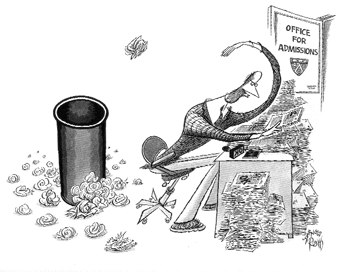 Once more, this year The Journal of Blacks in Higher Education has completed its survey of admissions offices at the nation’s highest-ranked national universities. Again, we determine the percentages of blacks in this fall’s freshman classes. As before, our survey also includes racial data on the first-year class at the nation’s leading liberal arts colleges. And, as in the past, our survey has obtained information at the various institutions on the number of African-American applicants, their acceptance rates, enrollment numbers, and yield rates (the percentage of students who eventually enroll in the college at which they were accepted).
Once more, this year The Journal of Blacks in Higher Education has completed its survey of admissions offices at the nation’s highest-ranked national universities. Again, we determine the percentages of blacks in this fall’s freshman classes. As before, our survey also includes racial data on the first-year class at the nation’s leading liberal arts colleges. And, as in the past, our survey has obtained information at the various institutions on the number of African-American applicants, their acceptance rates, enrollment numbers, and yield rates (the percentage of students who eventually enroll in the college at which they were accepted). 
 Remarkably, the Massachusetts Institute of Technology, with its emphasis on the natural sciences and engineering, has a good position in sixth place in our survey. There are 99 black freshmen at MIT this fall making up 9.3 percent of the entering class. In 2006 there were 81 black freshmen, who were slightly more than 8 percent of all entering students. MIT was able to achieve good results despite the negative publicity surrounding the dismissal of black professor James Sherley. Professor Sherley had gone on a hunger strike last winter to protest what he perceived as racism in the university’s hiring practices.
Remarkably, the Massachusetts Institute of Technology, with its emphasis on the natural sciences and engineering, has a good position in sixth place in our survey. There are 99 black freshmen at MIT this fall making up 9.3 percent of the entering class. In 2006 there were 81 black freshmen, who were slightly more than 8 percent of all entering students. MIT was able to achieve good results despite the negative publicity surrounding the dismissal of black professor James Sherley. Professor Sherley had gone on a hunger strike last winter to protest what he perceived as racism in the university’s hiring practices.  For the 29 high-ranking universities for which we have data for both this year and last, it is encouraging to report that 16 universities showed gains in black first-year enrollments. Thirteen high-ranking universities had declines in their number of black freshmen.
For the 29 high-ranking universities for which we have data for both this year and last, it is encouraging to report that 16 universities showed gains in black first-year enrollments. Thirteen high-ranking universities had declines in their number of black freshmen. 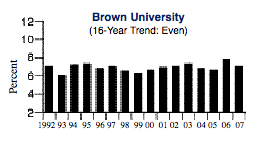
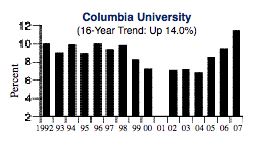
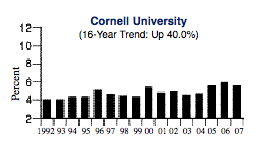
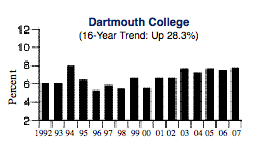
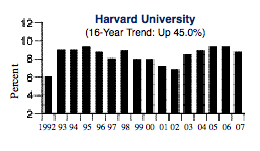
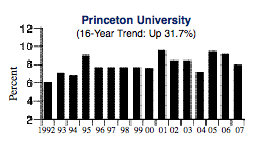
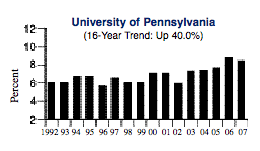
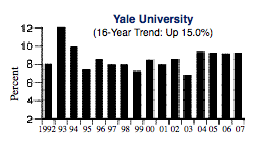

 Now we turn to a comparison of this year’s results with the data from last year. For the 28 colleges for which we have data, 17 colleges have posted gains in black enrollments while nine have fewer black freshmen than a year ago. Grinnell College and Carleton College have the same number of black freshmen as they had a year ago.
Now we turn to a comparison of this year’s results with the data from last year. For the 28 colleges for which we have data, 17 colleges have posted gains in black enrollments while nine have fewer black freshmen than a year ago. Grinnell College and Carleton College have the same number of black freshmen as they had a year ago.